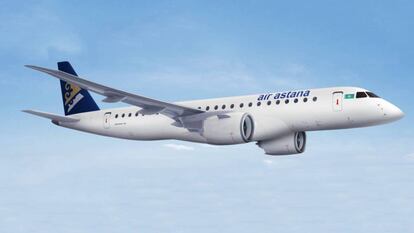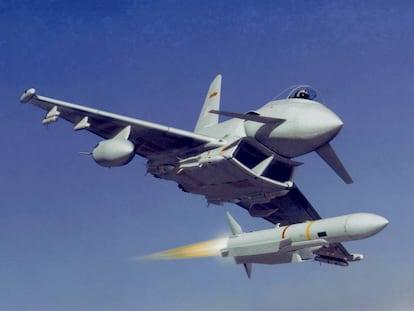“Sea or river?” The stark choice Lisbon airport gave a stricken plane for landing
For two hours on Sunday, an aircraft from a Kazakhstani airline was left in the air with no controls. It eventually touched down safely escorted by two F-16 fighter jets
Sea or river? The question wasn’t about the kind of fish you might want for lunch, but rather about the only two options for an emergency landing. For several agonizing hours, punctuated by silences, the pilot of a plane from the Kazakhstani airline Air Astana and the air traffic controllers at Lisbon airport were trying to decide how best to land the aircraft, which had lost its controls and was in the midst of a terrible rain and wind storm.
The plane was headed for Belorussia, but had made a technical stop at the military airport of Alverca
The incident took place on Sunday afternoon, and lasted for two dramatic hours, during which the plane took an erratic course between the Portuguese airports of Alverca, Lisbon and Beja, where it eventually landed without suffering any major damage.
The aircraft, an Embraer, had two pilots and four technicians on board. It was headed for Minsk, Belorussia, but had made a technical stop at the military airport of Alverca, around 30 kilometers from Lisbon. From there it took off without incident, but the crew decided to make a landing at the civil airport in Lisbon to check the repairs. After several attempts and more than half an hour flying over the city, the pilot made a Mayday call at 1.32pm local time (2.32pm in Spain). The electronic landing controls on the plane were not working.
The dramatic – albeit extraordinarily cool – conversations (in English) between the control tower and the pilot have been published on the Portuguese edition of the newspaper Público. The technical problems are clearly audible – the plane could only be flown manually – and there were also atmospheric problems too, with zero visibility due to a rain storm. In fact, Lisbon saw 10% of its annual rainfall in just one day on Sunday.
“Do you have visual contact with Alverca?” the control tower asks the pilot, who had lost his orientation. The advice from the tower was not exactly reassuring: “Turn to the right or the left.”
A few of the landing lights on the runway were broken in the process, and two of the people on board were suffering from anxiety
Six minutes later the pilot appears to abandon requesting more advice and requests permission to make an emergency landing. “In the water! Mayday. We need a vector for the sea, far from land.”
The pilot then decides to ask the tower about the skies. “Where are the skies clearer?” The tower tells him that the visibility is better in the south – but where is the south?
Two F-16 planes from the Portuguese air force took off from Montijo to guide the Air Astana plane. The chosen destination was Beja, 180 kilometers to the southeast of Lisbon, an airport that was built during the boom years but underutilized since its inauguration in 2009. For the stricken plane, it was perfect: long, wide, modern runways with clear signage and no major built-up areas close by.
Toward 3pm, the emergency services at the airport – which usually has no commercial use – were put on alert, with voluntary fire fighters and ambulance crews standing by. But after two hours of flight, the plane had recovered part of its electronic control systems, and, on the third attempt of the afternoon, the aircraft landed. A few of the landing lights on the runway were broken in the process, and two of the people on board were suffering from anxiety.
But in the end, the six crew members did not have to choose between the sea and the river for a crash landing. By 3.28pm they were back on terra firma and could tell their story.
One of the pilots was 37 years old and from Kazakhstan, while the other was from England, and aged 54
“It was the biggest fright of their lives,” said Pedro Barahona, a voluntary firefighter who spoke to one of the pilots. An ambulance crew checked over the passengers of the plane, and took two of the six crew to Beja hospital on account of their symptoms of stress and anxiety. They were discharged three hours later.
According to the information collected by the emergency services, one of the pilots was 37 years old and from Kazakhstan, while the other was from England, aged 54, and had 30 years of flight experience under his belt. He had only been flying with Air Astana for a couple of months.
“They were a little bit nervous,” explained the fireman, who accompanied the English pilot in the ambulance.
The six crew members can now tell the story of how they survived a “critical failure in the navigation and flight control systems,” as well as a Mayday.
English version by Simon Hunter.
Tu suscripción se está usando en otro dispositivo
¿Quieres añadir otro usuario a tu suscripción?
Si continúas leyendo en este dispositivo, no se podrá leer en el otro.
FlechaTu suscripción se está usando en otro dispositivo y solo puedes acceder a EL PAÍS desde un dispositivo a la vez.
Si quieres compartir tu cuenta, cambia tu suscripción a la modalidad Premium, así podrás añadir otro usuario. Cada uno accederá con su propia cuenta de email, lo que os permitirá personalizar vuestra experiencia en EL PAÍS.
¿Tienes una suscripción de empresa? Accede aquí para contratar más cuentas.
En el caso de no saber quién está usando tu cuenta, te recomendamos cambiar tu contraseña aquí.
Si decides continuar compartiendo tu cuenta, este mensaje se mostrará en tu dispositivo y en el de la otra persona que está usando tu cuenta de forma indefinida, afectando a tu experiencia de lectura. Puedes consultar aquí los términos y condiciones de la suscripción digital.
More information
Archived In
Últimas noticias
Maduro pleads not guilty before the federal court in New York: ‘I am still the president of Venezuela’
A new test can detect Alzheimer’s from a finger prick
UN team enters Sudanese city of El Fasher after paramilitary massacre: ‘It’s like a ghost town’
A recipe for resistance: Indigenous peoples politicize their struggles from the kitchen
Most viewed
- Gilles Lipovetsky: ‘If you want to live better and fall in love, take Prozac, don’t look to philosophy’
- Alain Aspect, Nobel laureate in physics: ‘Einstein was so smart that he would have had to recognize quantum entanglement’
- Alvin Hellerstein, a 92-year-old judge appointed by Bill Clinton, to preside over Maduro’s trial in New York
- Maduro’s downfall puts China’s relationship with Venezuela to the test
- Why oil has been at the center of Venezuela-US conflicts for decades











































